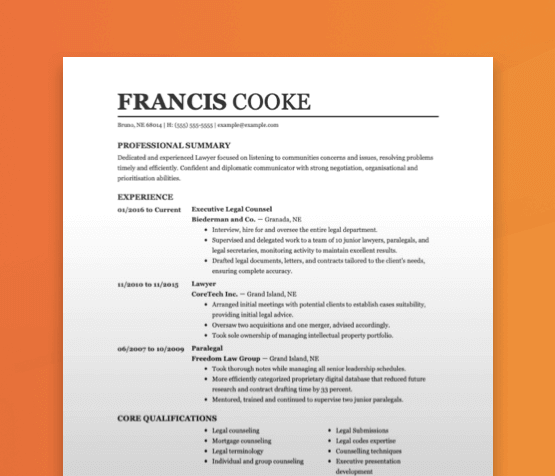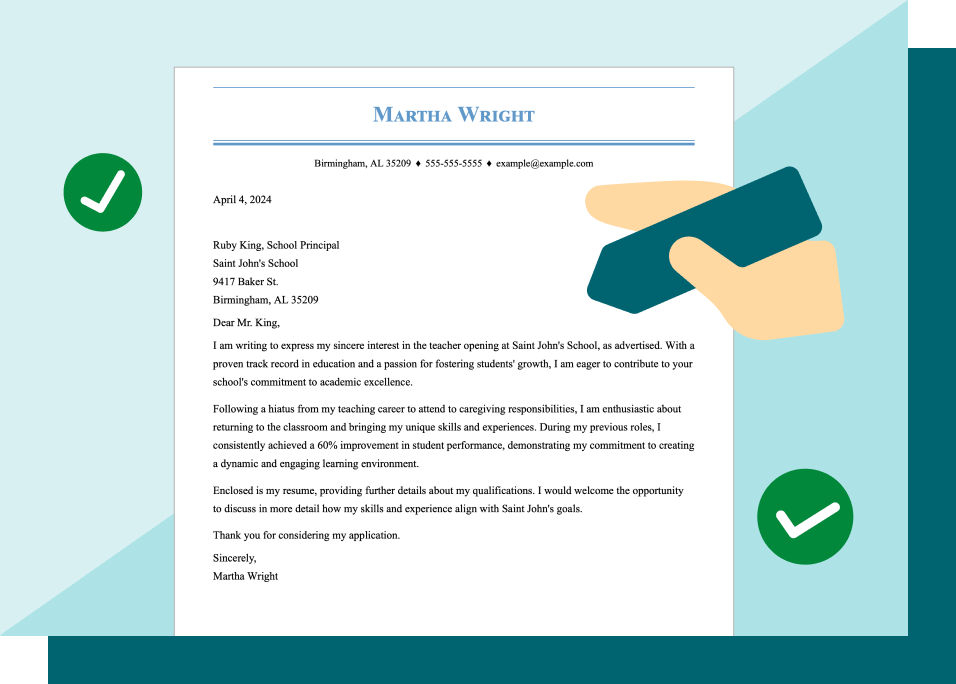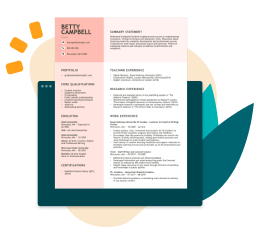Medical Student CV Example & Writing Guide
A well-written medical student CV can get you into a career-defining academic opportunity. Check out our best CV for medical students plus tips for impressing recruiters.
Medical Student CV Example
A curriculum vitae (CV) is your best choice when applying to medical school or any other academic program that prepares you to become a doctor of medicine.
Unlike resumes, CVs showcase your entire educational background and provide ample space to list required achievements to enter medical school, such as research experience, publications, volunteer work and more.
Check out this medical school CV template to get an idea of how yours should look like:
How to Write a Medical Student CV
A successful CV for medical school should showcase all the valuable experiences and skills you gathered while completing your bachelor’s degree. Most college students who aspire to become doctors major in biology or chemistry, and generally complement their education with extracurricular activities in medicine.
The following guide will help you organize all the required information you need to apply to med school and write a CV in an easy, step-by-step process. Let’s start!
Medical student CV sections
- Contact Information
- CV Summary or CV Objective
- Education
- Research Experience
- Clinical Experience
- Volunteer Experience
- Skills
- Publications
- Awards and Honors
- Grants and Fellowships
- Conferences
You don’t need to include every section, but they are all common in most medical school CV examples.
Curriculum vitae are the longest job application documents, and writing one without previous experience can seem daunting. To help students like you, we’ve created a user-friendly CV Maker to make you a custom medical CV in minutes.
If you already have a CV you just want to update, this guide will help you fine-tune it to ace those med school applications. Remember to run it through our ATS CV Checker to ensure it’s primed to bypass applicant tracking systems (ATS).
Now, let’s review each medical CV section in detail and look at some examples.
1. List your contact information.
This one’s pretty straightforward. Your CV should have a section at the top of the first page listing your contact details. Always include the following in your medical student CV template:
- First and last name
- Phone number
- Email address
- City and state of residence
Example:
Miranda Carter
555-555-5555 | example@example.com | San Diego, CA
You may also add optional details such as your LinkedIn profile, personal website (if related to your medical pursuits) or publications portfolio.
2. Introduce yourself with a summary or objective.
Depending on your experience, you’ll opt for a CV summary or a CV objective to introduce yourself to the med school admissions team.
These sections serve the same purpose: they function as brief presentations where you list your most relevant qualifications as an aspiring medical student.
The main difference is that whereas the CV summary is more straightforward and focused on achievements, the CV objective lets less experienced students demonstrate their unique aspirations and goals for medical school.
Crucial information that could go on your medical student CV summary or objective are:
- Your major and minor
- Your GPA
- Relevant coursework
- Research that aligns with your desired medical field
- Volunteer work
- Experience shadowing physicians
- Internships
- Clinical experience
- Hard and soft skills
- Passion for medicine and career aspirations
Your CV profile doesn’t have to include every one of these items. Carefully select the information that best reflects the skills, qualifications and characteristics the particular med school program is looking for in prospective students. To do this, you’ll need to study the admissions requirements and the school’s mission and values.
3. Outline your work experience.
The education section is one of the most important sections in a medical CV template. It will outline your entire academic background and show admissions teams whether you have the necessary education and grades to thrive in medical school or a residency program.
When writing a CV for medical students, your education section should list:
- Your degree
- The name of your college or university
- The city and state where the college is located
- Expected graduation date (for active students)
Feel free to add details that provide more insight into your education, such as:
- GPA
- Relevant coursework
- Research projects
- A relevant award or honor
- Grants or fellowships
Here’s an example of how a medical student CV education section should look like:
Education
Bachelor of Science in Biology
University of Chicago – Chicago, IL
GPA: 3.85/4.0
Honors: Dean’s List (all semesters), Magna Cum Laude
Relevant Coursework:
- Human Anatomy and Physiology
- Biochemistry
- Molecular Biology
- Microbiology
- Immunology
4. Showcase your research experience.
As a college student, you’ll be busy with classes of all types, but a great way to prepare for medical school applications is to take up any research opportunity.
These research experiences can range from experiments in laboratory research classes to experiences outside the classroom, like assisting in clinical research at a local hospital or university medical center.
Here’s an example of what a “Research Experience” section can look like in a medical student’s CV:
Research Experience
Undergraduate Research Assistant
Department of Molecular Biology, Johns Hopkins University, Baltimore, MD
May 2022 – August 2023
- Conducted research on the role of microRNAs in regulating gene expression in cancer cells under the supervision of Dr. Patel.
- Collected, analyzed and interpreted experimental data to identify patterns of microRNA expression in different cancer cell lines.
- Contributed to the paper submitted for publication in the Journal of Molecular Oncology.
5. Emphasize your clinical experience.
If you’re currently enrolled in medical school and are updating your CV to apply for a residency or fellowship, you’ll want to focus on the clinical experience you’ve acquired.
Clinical experience shows your skills in patient care and working in the field, which is the backbone of practicing medicine.
Here’s an example of how to maximize the “Clinical Experience” section of your medical student CV:
Clinical Experience
Shadowing Experience
Massachusetts General Hospital, Boston, MA
August, 2022 – November, 2022
- Shadowed Dr. Jeffries in pediatrics and internal medicine departments.
- Observed patient consultations, physical examinations and diagnostic procedures.
- Gained firsthand experience in patient-doctor interaction, understanding patient needs and clinical decision-making.
- Logged over 80 hours of shadowing experience.
6. Mention any volunteer work.
Although not strictly required, a relevant volunteer work section within your medical student CV can do wonders for your applications.
Showing schools you’re genuinely passionate about patient care will add to the fact that you’re their ideal candidate.
Like other experience sections, note the name of the place where you provided your volunteer work, its location, the dates you volunteered, and bullet points with key duties and accomplishments.
Here’s an example of a “Volunteer Work” section for a medical student CV:
Volunteer Experience
Volunteer, Emergency Department
Providence St. Joseph Hospital Orange, Orange, CA
February 2023 – May 2023
- Assisted emergency department staff by escorting patients and providing support during patient intake.
- Delivered essential supplies to nursing stations, maintained medical equipment and observed trauma care protocols.
- Logged 100+ hours of volunteer service.
7. Add variety to your skills section.
A medical student CV example wouldn’t be complete without a skills section listing your best and most valuable skills.
Include a simple bulleted list of soft skills and hard skills that demonstrate you’re a well-rounded candidate with the medical knowledge and personal skills to excel as a future doctor!
Here are some ideal skills to have in your medical school CV:
- Clinical documentation
- Vital signs monitoring
- Basic Life Support (BLS)
- Phlebotomy
- Suturing
- Electronic Medical Records (Epic, Cerner)
- Familiarity with REDCap
- Proficiency with statistical software (R, SAS)
- Data collection and analysis
- Research report writing and literature reviews
- Critical thinking
- Empathy and patient-focused care
- Diversity and inclusion
- Time management
- Resilience and grit
- Complex problem-solving
8. List your publications.
Whether you want to become a doctor to practice patient-focused medicine or pursue a research career, you’ll want to have a few published articles under your name.
Peer-reviewed publications validate your research and give you credibility. Universities can read your publications and learn more about your areas of interest and the scope of your talents.
Here’s an example of a “Publications” section for a medical student CV:
Publications
Durand J, Smith A, Rodriguez G.
“Role of microRNAs in Tumor Suppression: A Study on Breast Cancer Cells.” Journal of Molecular Oncology. 2024; 15(3):245-256. doi:10.1234/jmo.2024.003.
Rodriguez G, Johnson P, Lee S.
“Improving Patient Outcomes Through Mobile Health Applications: A Clinical Trial.” American Journal of Public Health. 2023; 113(4):789-794. doi:10.2105/AJPH.2023.456.
9. Boast your awards and honors.
If you have two or more awards or honors in your academic career, you may add a separate CV section to list these accomplishments.
Don’t be shy about boasting your merits; medical schools are eager to snag the top candidates. Therefore, an awards section is entirely appropriate when applying to medical school.
Here’s how an “Awards and Honors” section will look on a medical student CV:
Awards and Honors
Recipient, Undergraduate Research Scholarship
Harvard University | May 2022
- Awarded $2,500 to support research on effects of environmental toxins on cardiovascular health.
Magna Cum Laude
Harvard University | Graduation Date: May 2023
- Graduated with honors, achieving a GPA in the top 10% of the graduating class.
Outstanding Biology Student Award
Harvard University | May 2021
- Awarded to top students in the biology department for academic excellence and research contributions.
10. Add a section for grants and fellowships.
Another excellent way to stand out when applying for medical school or residency programs is to showcase any grants you were awarded or participation in fellowships.
Fellowships, in particular, are common experiences many students have between college and medical school or medical school and residency.
Here’s how this section may look like on your medical student CV:
Grants and Fellowships
National Institutes of Health (NIH) Summer Research Fellowship
June 2023 – August 2023
- Awarded $4,500 to research the role of gut microbiota in developing autoimmune diseases.
- Conducted laboratory experiments and analyzed data using bioinformatics tools.
- Presented findings at NIH Summer Research Symposium.
Undergraduate Research Grant
Boston College | September 2022 – May 2023
- Received $3,000 to support independent research on the effects of air pollution on respiratory health in urban populations.
- Designed and implemented study using clinical data and environmental monitoring to assess long-term impacts.
11. Demonstrate your interests with a conferences section.
Including a “Conferences” section in your medical school CV shows your active engagement in the medical community and demonstrates your commitment to continuous learning and professional development.
When listing conferences, prioritize those most relevant to your medical interests and emphasize any presentations or significant outcomes.
Here’s an example of a medical student CV “Conferences” section:
Conferences
Presenter, Annual Meeting of the American College of Cardiology
Boston, MA | March 2024
- Presented poster titled “Evaluating the Role of MicroRNA in Cardiovascular Disease Prevention.”
- Engaged with leading cardiologists and researchers to discuss advancements in cardiology.
Attendee, Global Health Conference
New York, NY | September 2023
- Participated in workshops on global health policy and innovations in healthcare delivery in resource-limited settings.
- Networked with global health leaders and gained insights into international healthcare challenges.
A medical school CV is an elaborate document, but you can easily make yours with the help of our CV Builder. Take advantage of our automatic formatting and prewritten text suggestions to create a medical student CV in minutes!
Tips for a Great Residency CV
Applying for medical school is one thing, but preparing for a residency match requires you to include different details in your CV.
Follow these tips to ensure your medical student CV is primed to impress your dream program.
1. Tailor your CV to the specialty you want to pursue.
Program directors look for candidates who commit to their specialty and possess the required relevant skills. Therefore, focus on experiences, skills and qualifications that align with the medical field you want to pursue.
For example, if you’re applying to surgery, emphasize your surgical rotations or research in related fields. If you’re applying to a pediatrics residency, include your pediatric rotations, relevant volunteer work (e.g., working with children) and any pediatric-related research.
2. List away rotations (externships).
Away rotations allow you to gain experience in different healthcare settings and show your commitment to a specialty or specific program.
Include details about any away rotations (also called externships) at other institutions, especially if they relate to your desired specialty. Mention if you worked in a setting similar to the residency program you’re applying for, such as rural or urban environments.
3. Highlight any teaching or mentorship experiences.
Many residency programs include teaching responsibilities. Experience teaching medical knowledge is a strong asset, especially for academic-based residencies.
If you have served as a teaching assistant, tutor or mentor to junior medical students, include these experiences in your CV for residency.
4. Address gaps or transitions in your training.
If you have any gaps in your work history or education (such as taking time off for research, pursuing another degree or personal reasons), briefly explain these in your CV or cover letter.
Program directors appreciate transparency and will want to understand your journey. Addressing gaps proactively shows maturity and accountability. For example:
Gap Year (2022-2023)
Took a year off between medical school and residency to participate in a global health fellowship, providing care to underserved populations in rural Kenya. Gained experience in tropical medicine and healthcare delivery in resource-limited settings.
5. Mention leadership roles in medical student organizations.
Leadership experience shows initiative, responsibility and the ability to manage teams — qualities valued in residents who may eventually take on leadership roles.
Mention leadership roles in organizations like:
- American Medical Association (AMA)
- American Medical Student Association (AMSA)
- Specialty interest groups (surgery, internal medicine, pediatrics, etc.)
- Doctors Without Borders Student Chapter
- Research interest groups (clinical, translational, biomedical)
More Medical School CV Templates
Browse these CVs for medical students for different specialties and scenarios. Click on the button below each medical student CV template to customize it with your details in our builder.
Surgery medical student CV example
Pediatrics medical student CV example
Internal medicine medical student CV example
Emergency medicine medical student CV example
Research medical student CV example
OB-GYN medical student CV example
Psychiatry medical student CV example
FAQ
How long should a medical student CV be?
A medical student CV can be anywhere from one to 10 pages long, depending on your experience. While there’s flexibility on the length of your CV, aim to keep it concise by focusing on relevant education, clinical experiences, research and volunteer work. Include all necessary sections, but avoid excessive details that don’t directly support your residency or medical career goals.
Do I need to include nonmedical jobs in my CV?
Not necessarily. You can simply stick to experiences related to your medical education and career, but ensure you explain any gaps in your CV or in a cover letter. Including nonmedical jobs in your CV is entirely appropriate if you focus on transferable skills that can aid you in medical school.
What’s the difference between a CV and a resume for medical students?
A CV provides a comprehensive overview of your academic and professional career, including skills, qualifications and publications, without length restrictions. A resume is shorter (typically one page) and focuses on specific skills and experiences. Medical students often use CVs for residency, but a medical resume template might suit you better, depending on your specific needs.
What certifications should I include on my medical student CV?
Some common certifications medical students should have in their CV are:
- Basic Life Support (BLS)
- Advanced Cardiovascular Life Support (ACLS)
- Pediatric Advanced Life Support (PALS)
- Advanced Trauma Life Support (ATLS)
- HIPAA Certification
- Infection Control Certification
- Research Certifications (CITI Program)
Should I include hobbies or personal interests in my medical school CV?
Including hobbies or interests is optional but can be beneficial when applying to medical school if they highlight qualities like teamwork, leadership or stress management. Choose interests that reflect skills or attributes that can make you a more well-rounded applicant, but avoid irrelevant or overly personal details that don’t provide insight into your professional profile.











